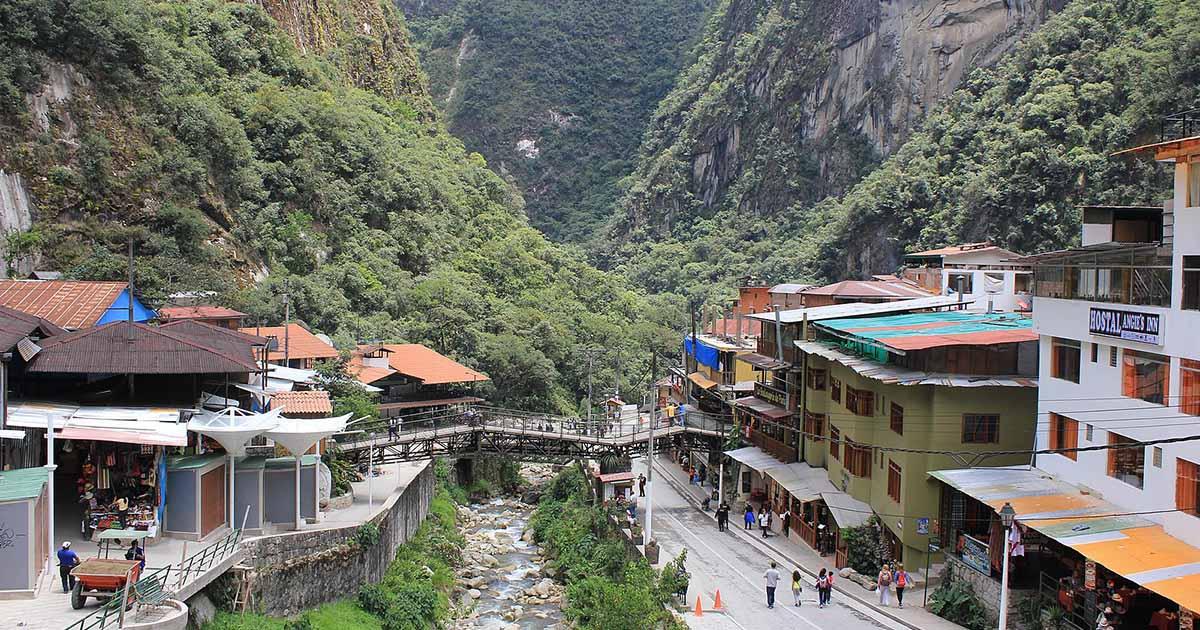
Machu Picchu’s popularity put Aguas Calientes on the map. The town may not be a destination in its own right, like Cusco or the Sacred Valley, but you can appreciate Aguas Calientes for what it is: a bustling tourism hub.
The town was renamed Machu Picchu Pueblo, but it continues to go by its original name. Everything in Aguas Calientes orbits around shuttling backpackers, families and friends to and from Machu Picchu. The train station is one of the central nodes of town, and hotel breakfasts start as early as 5 a.m. for guests with early entry into the historic site. Trekkers soak their sore muscles at the hot springs, and menús del día (daily specials) entice hungry travelers to restaurant tables.
Albeit touristy, Aguas Calientes is filled with the excitement of exploring Machu Picchu and makes the town feel special. While in town, go souvenir shopping or take a nature walk through the beautiful cloud forest. The activities in the Things to Do section are second-tier attractions in Aguas Calientes, but fun ways to fill your time around your visit to the paramount Inca citadel up the mountain.
Whether you’re coming or going from Peru’s famous attraction, you need to pass through town at some point along your journey. The mountainous geography limits access to this isolated region of Peru so much so that your only options for getting to Machu Picchu are taking the train or trekking. There are no paved roads from the Sacred Valley or Cusco, so you cannot hire a taxi, drive your car, or take a bus to Aguas Calientes.
Most travelers arrive at Aguas Calientes via a comfortable train ride through stunning Andean scenery. Routes range from 3.5+ hours from Cusco and 1.5+ hours from the Sacred Valley. For many passengers, the scenic train to Machu Picchu and pleasant onboard entertainment are highlights of their trip.
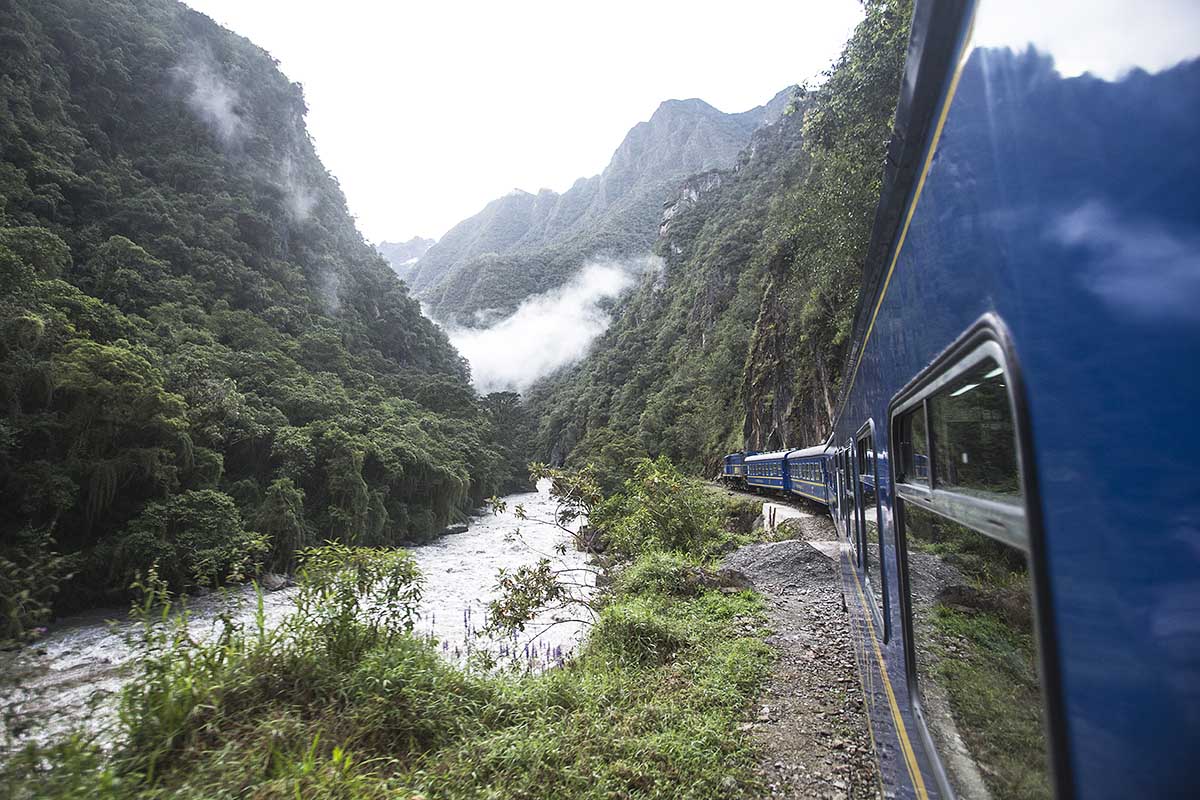
From Ollantaytambo, the train to Machu Picchu continues through a narrow section of the Sacred Valley covered in lush green vegetation all the way to Aguas Calientes. Photo by Peru For Less.
From the first-class Belmond Hiram Bingham Train to other more modestly priced options, the tickets booked by your Travel Advisor will match your preferences and align with the timing of your tour of Machu Picchu.
Tickets for the train are in high demand during June, July and August in the peak dry season. Consequently, tickets regularly sell out several days if not weeks in advance. Buying your tickets upon arrival is not recommended, especially if your time in Peru is limited, because the dates and departure times you desire might not be available.
PeruRail operates service to Aguas Calientes from train stations in Cusco as well as Ollantaytambo in the Sacred Valley. In Urubamba, PeruRail also runs an exclusive train service from a small station at the Belmond Hotel Rio Sagrado. Inca Rail is another company that provides onboard services on par with PeruRail.
The following table lists the time it takes to travel by train from stations in Cusco and the Sacred Valley to the Machu Picchu Train Station (aka Aguas Calientes Train Station).
| Departure Point | Train Station | Time to Aguas Calientes |
| Cusco | San Pedro Station | ~4.5 hours |
| Cusco | Poroy Station | ~3.5 hours |
| Sacred Valley | Urubamba Station | ~2.5 hours |
| Sacred Valley | Ollantaytambo Station | ~1.5 hours |
Taking a trek to Machu Picchu is your second option for arriving to Aguas Calientes. The Inca Trail is iconic because it is the only trek that ends at the Sun Gate entrance of Machu Picchu. A few Inca Trail alternatives include Lares, Salkantay and Choquequirao, which are treks that do not end by hiking directly into the ruins. Instead, the trekking and camping portion concludes on the second to last night of the tour package. After a final night in one of the Aguas Calientes hotels, the trekkers take the shuttle bus up to the main entrance of Machu Picchu and tour the site.
Compare the following trekking package itineraries for the 4-day Inca Trail versus the 2-day Inca Trail.
| 4-Day Inca Trail | 2-Day Inca Trail | |
|
Itinerary & Distance | 4 days of trekking, | Day 1 trek (7 mi | 11 km) to Machu Picchu + Day 2 tour of Machu Picchu |
|
Permit Required | + Inca Trail permits must be secured in advance. | |
| Machu Picchu Arrival | On foot through the Sun Gate, followed by a tour of Machu Picchu on the same day. | On Day 1, on foot through the Sun Gate. Then, for the guided tour on Day 2, take the bus shuttle from Aguas Calientes to the main entrance. |
| Camping or Hotels | All 3 nights camping | 1 night at a hotel in Aguas Calientes |
Trekking Tours:
The classic Inca Trail to Machu Picchu might be the most popular, but these alternative treks should not be overlooked.
|
Itinerary & Distance | 4 days, | 5 days, | 8 days, |
| No Permit Required | No trekking permit required for any of the alternative treks to Machu Picchu. | ||
| Machu Picchu Arrival | By bus from Aguas Calientes to the main entrance. | ||
Camping or Hotels | 2 nights camping, | 3 nights camping, | 6 nights camping, |
Compare the treks to Machu Picchu.
For travelers with more time than money, a lesser-known way to Aguas Calientes is to travel by bus from Cusco to Santa Teresa and walk 2 hours or take the train from the Hydroelectric Station. This requires a full day of travel (one-way). The Salkantay trek also ends at Santa Teresa.
You can get across Aguas Calientes on foot in about ten minutes, but be prepared to go up and down stepped paths. Walking is the only way to get around town as there is no motor transport apart from the shuttle bus to Machu Picchu.
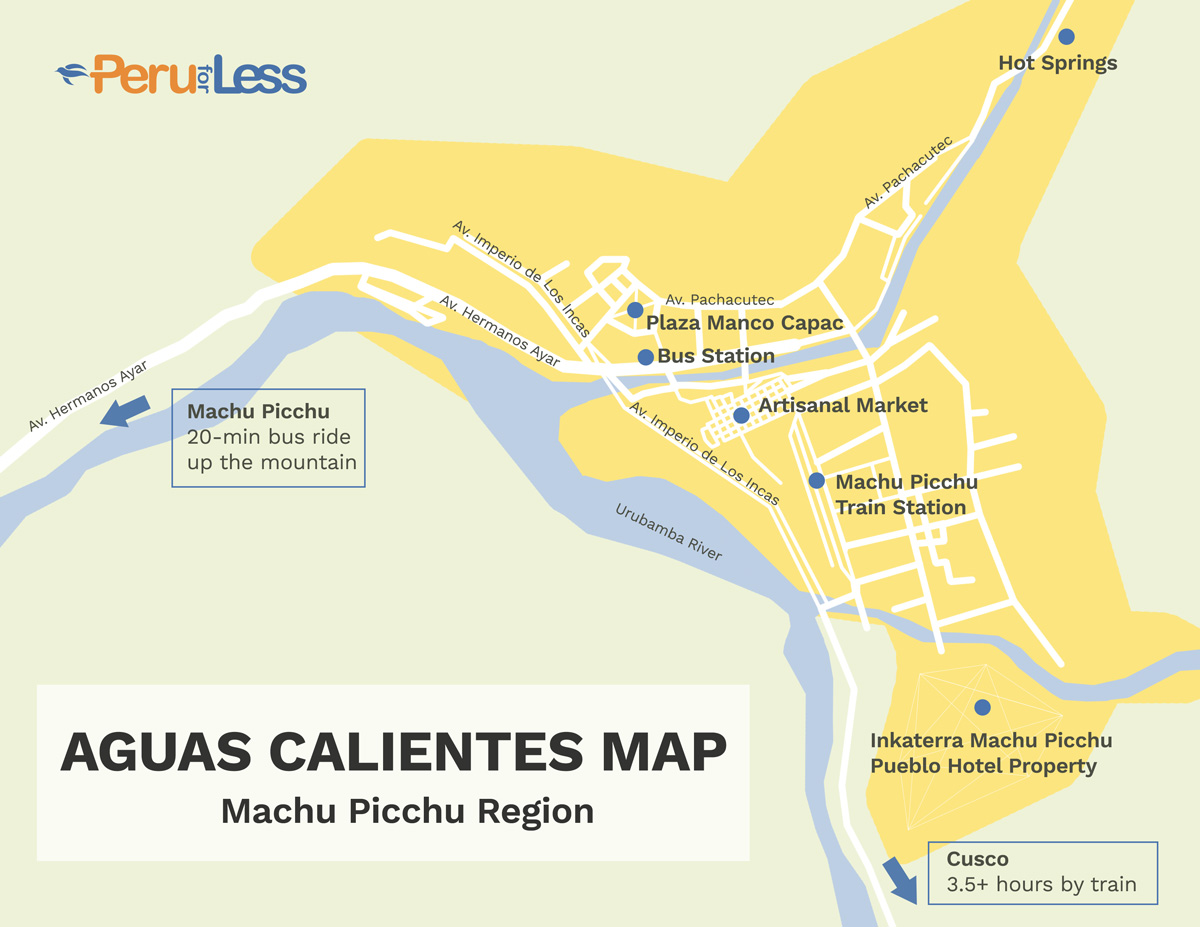
Map of Aguas Calientes Peru by Peru For Less.
The Machu Picchu Train Station is in the heart of town. Your Travel Advisor can arrange for our representative to meet you outside the station gates and escort you to your hotel or directly to the bus station in Aguas Calientes for the ride up to Machu Picchu.
Machu Picchu is 5.5 miles (9 km) up the mountain from Aguas Calientes. There are only two ways of getting from Aguas Calientes to Machu Picchu: by bus or on foot.
A fleet of buses operated by Consettur Machupicchu takes passengers between Aguas Calientes and the main entrance of the ruins. The route it takes is up a steep switchback road called Carretera Hiram Bingham. Buses run from the bus stop on Av. Hermanos Ayar in Aguas Calientes from 5:30 a.m. to 2:30 p.m. and depart as soon as a bus is full or every 15 minutes. In total, the bus trip takes 20-minutes to go up. The last bus back from the ruins to town is at 5:30 p.m.
All of our Machu Picchu tour packages include this roundtrip bus fare. You can also purchase tickets online at the Consettur website or in person at offices in Cusco, Aguas Calientes and up at the main entrance to Machu Picchu.
It’s a steep climb from the river up to the entrance of Machu Picchu. You can walk along the dirt 4.5-mile (7 km) road or take the steeper stepped footpath. However, if you intend to get a taste of Andean hiking, there are better, more scenic trails within Machu Picchu.
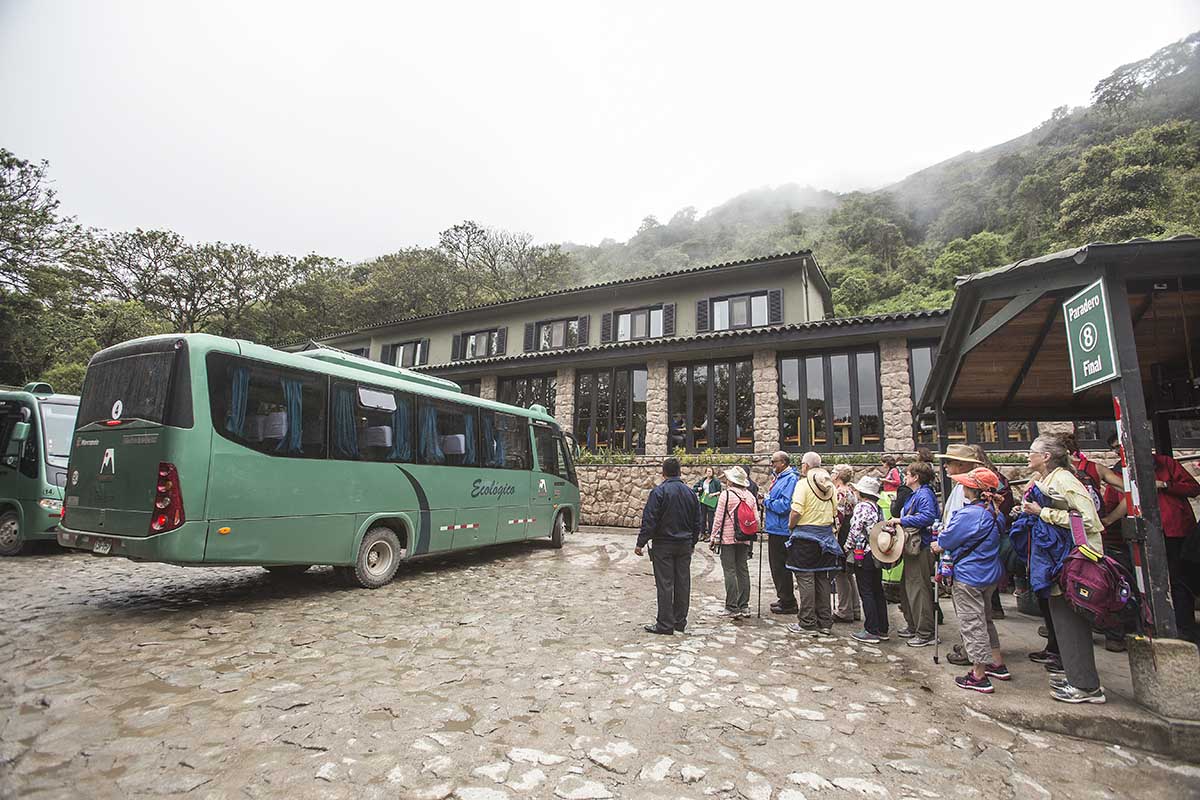
After touring Machu Picchu, visitors wait for the shuttle bus to take them down the mountain to Aguas Calientes. Photo by Peru For Less.
Travelers come to Aguas Calientes to see Machu Picchu. This section highlights important ticket regulations and itinerary options. Check out our Machu Picchu Travel Guide for more detailed information.
Tickets for Machu Picchu must be purchased in advance. If you wait until the last minute, your final opportunity is at the Oficina Instituto Nacional de Cultura (INC office) on the main plaza in Aguas Calientes (open daily from 5:00 a.m. to 10:00 p.m.). No tickets are sold at the ruins. To enter, you are required to present your passport along with your ticket. No exceptions.
Travel itineraries with at least one night in Aguas Calientes break up the long travel time if you’re coming from Cusco (3.5+ hours each way). Staying overnight in town also helps you enjoy the Machu Picchu leg of your trip at a slower pace.
Top reasons to spend the night in Aguas Calientes include:
You can plan a whirlwind trip to Machu Picchu in one day if your time in Peru is limited. Instead of Cusco, depart from the train station in Ollantaytambo to cut down on the travel time to Aguas Calientes, and then take the bus shuttle up to Machu Picchu. Feel the rush of your once-in-a-lifetime experience through the Inca citadel! Take the bus back to town. Then towards the end of a busy but rewarding day of discovery, head to the train station for a return trip to Ollantaytambo or Cusco.
Machu Picchu Tours:
Soaking in the local hot springs is a favorite attraction of trekkers seeking a bit of relaxation after finishing their grueling trek to Machu Picchu. The best part of the hot springs is the granite cliff scenery that encloses them. There are pools of different temperatures ranging from 100°F (38°C) to 115°F (46°C), as well as an icy cold one. Facilities include changing rooms, toilets, and a small bar serving drinks and snacks.
Entry: 11 soles (3 US dollars) per adult
Step beyond the train station gates and find a labyrinth of stalls at Mercado Artesanal. Here, browse collections of stone and wood carvings, alpaca wool sweaters, silverware and jewelry, clay sculptures, embossed leather, paintings, and even antiques. This market is the perfect place to buy Peruvian souvenirs before catching an outbound train. Prices tend to be higher than what you’ll find in Cusco and the Sacred Valley.
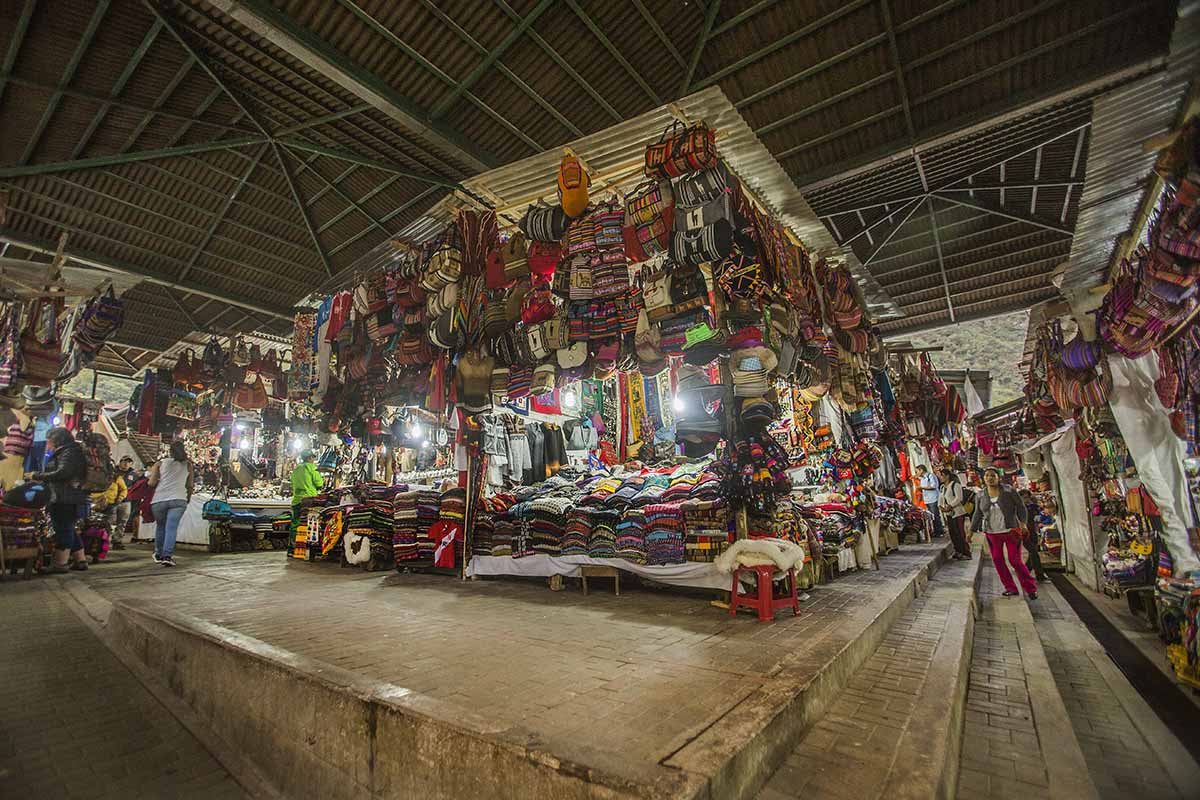
Go souvenir shopping at the market in Aguas Calientes. Photo by Peru For Less.
The UNESCO Historic Sanctuary of Machu Picchu covers 80,540 acres (32,600 ha), protecting not just the archaeological site, but the Andean cloud forest environment that surrounds it. Mild, humid temperatures and regular rainfall give life to thick green foliage and remarkable diversity, including more than 300 species of orchids, endangered spectacled bears and hundreds of bird species (making it perfect for birdwatching).
Mandor is a small but beautiful waterfall within Los Jardines de Mandor (Mandor Gardens), a privately operated ecological conservation and reforestation project on the banks of the Urubamba River. Take a free afternoon in Aguas Calientes and make the trip to explore the botanical gardens and see the falls. Jardines de Mandor also has a small restaurant and ecolodge. The 2.5-mile (4 km) walk there takes 50 minutes.
Alternatively, if you prefer to stick closer to Aguas Calientes, the natural beauty of the region is showcased in the gardens surrounding Inkaterra Machu Picchu Pueblo Hotel. Even if you’re not a hotel guest, you can order from the menu at the on-site Inkaterra Cafe and take a stroll around the property. Wander along the garden paths and spot exotic bromeliads, butterflies, birds and more.
The Museo de Sitio Manuel Chávez Ballón is a must-see attraction in Aguas Calientes with exhibits that explore the history, culture and rediscovery of Machu Picchu. Especially interesting are the explanations of Inca building methods. An adjacent botanical garden showcases various species of orchids, coffee and coca plants, and other flora native to the cloud forest. The only way to get to the museum, 1 mile (2 km) from Aguas Calientes, is on foot.
Address: Altura del Antiguo Puente Ruinas, Km 112 of the train tracks
Entry: 22 soles (About US $6) per adult
The Sacred Valley winds through the eastern slopes of the Andes down to tropical mountain forests bordering the Amazon Rainforest. Here, 70 miles (112 km) east of Cusco, the Inca Empire constructed Machu Picchu on a high saddleback ridge formed between Huayna Picchu and Machu Picchu Mountain. Far below, the Urubamba River flows past Aguas Calientes along the valley floor.
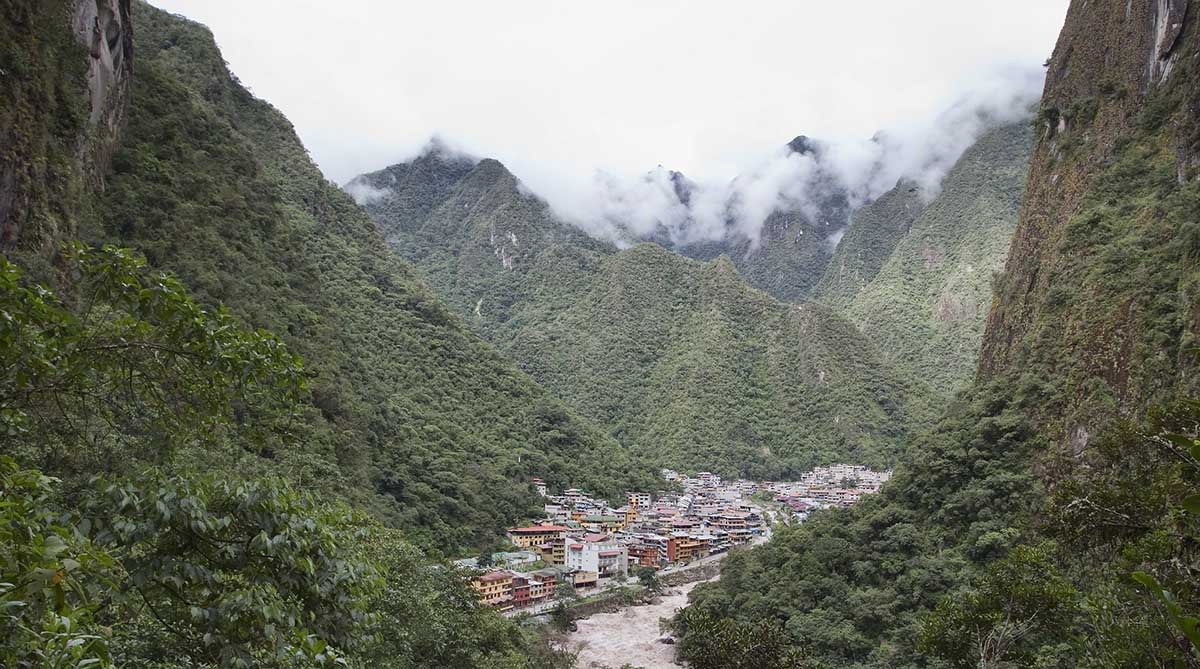
Aguas Calientes is far below the mountaintop ruins of Machu Picchu. Aguas Calientes by Bas Wallet, used under CC BY 2.0 / Compressed from original
The lower elevation and cloud forest environment cause the weather in Machu Picchu and Aguas Calientes to be much different from Cusco. For starters, there is not a strict separation between the rainy season (November to March) and the dry season (April to October). On the one hand, rain is possible at any time of the year around Machu Picchu. On the other hand, even in the rainy season, clear blue skies are not uncommon after a rainstorm.
In general, days in Aguas Calientes are humid and pleasant. Temperatures average between 68°F to 80°F (20°C to 27°C). Nights in the region are colder, though usually warmer than Cusco. Evening temperatures in the rainy season are warmer.
The best time to visit Machu Picchu and Aguas Calientes depends on your preferences about the weather, crowds and what trek you may want to do.
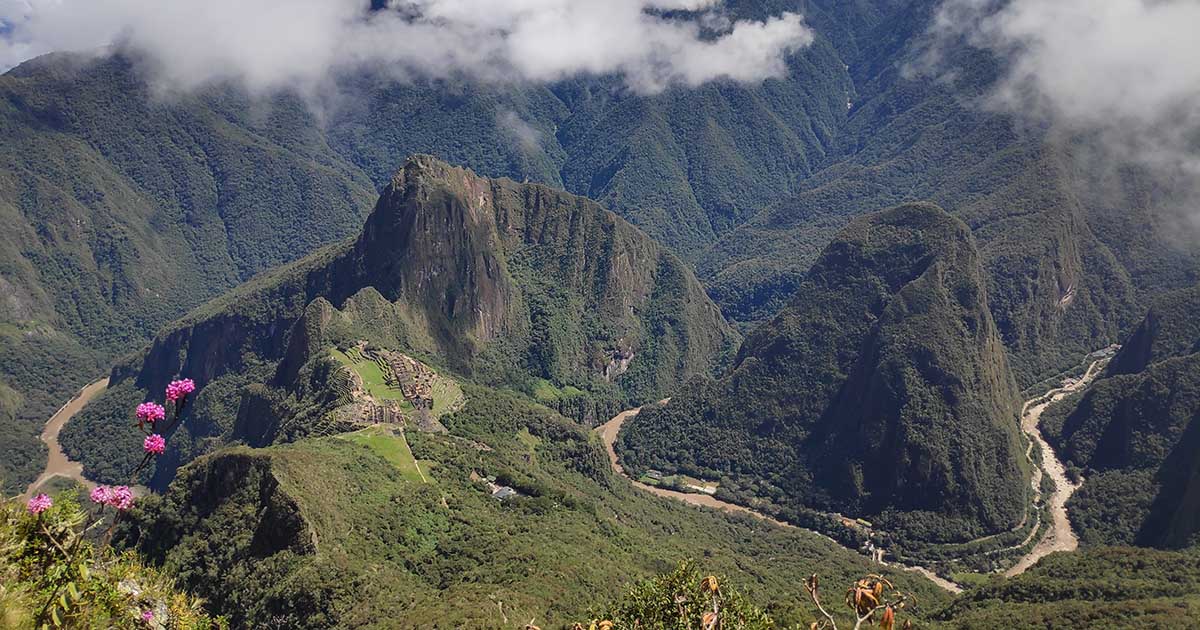
Aerial view of the Inca citadel from the Machu Picchu Mountain hike. Photo by Lizzie Thomas of Peru For Less.
Altitude sickness in Peru is a common concern. Many travelers only experience minor symptoms of acute altitude sickness. These include shortness of breath, headache, loss of appetite or nausea as a result of the elevation change. Everyone reacts differently, but severe reactions to high elevations are rare and hard to predict.
Elevation Comparison:
Cusco is higher than Machu Picchu by 3,150 feet (970 m). If you spent a few days in the city acclimating, you should be able to explore the Inca ruins upon arrival in Aguas Calientes without any issues.
Most travelers coming to Machu Picchu generally stay at a hotel in Aguas Calientes. There’s only one hotel next to the main entrance of Machu Picchu, Belmond Sanctuary Lodge. However, keep in mind that there is no transportation between the luxury lodge and Aguas Calientes after the buses stop running at 5 p.m. Also, prices for rooms are often in the four digits.
Inkaterra Machu Picchu Pueblo Hotel offers guests first-class amenities and utterly comfortable bungalows nestled amid the exuberant vegetation of the cloud forest. A few minutes on foot from the train station, this 5-star hotel is ideal for unwinding before or after a tour to Machu Picchu.
Our in-house videographer captured the charm of this stunning hotel in Aguas Calientes.
Discover more highlights of our selection of recommended Machu Picchu hotels. Accommodations range from 5-star luxury and comfortable 3-star options to simple B&B type accommodations.
Aguas Calientes is a highly transitory destination, packed with dozens of restaurants serving a standard menu of Peruvian and international dishes like pizzas, burgers and Mexican food. However, the gastronomical boom of Peru is so far-reaching that its aftershocks are felt even in an outpost like Aguas Calientes. If you’re looking for a memorable meal after your Machu Picchu exploration, there are a few restaurants to check out.
The Tree House Restaurant (Jiron Huanacaure 105) is a few steps above the rest, in both the culinary and the literal sense. Up a steep alleyway on the edge of town, the restaurant menu boasts Peruvian fusion cuisine shaped by Andean, Italian, Asian and Latin American influences.
Incontri el Pueblo Viejo (Av. Pachacutec, block 6, no number) is a place to satisfy your cravings for carbs with wood-fired pizzas featuring fresh toppings, as well as homemade pasta. Order your meal with a craft beer or an Italian or South American wine.
Chullpi Machupicchu (Av. Imperio de Los Incas 140) serves mouth-watering Peruvian fusion dishes such as trout ceviche, perfectly grilled chicken breast, delicious salads and tasty appetizers. If you’ve got room for dessert, go for the tres leches cake.
La Boulangerie de Paris Cafe (Puente Sinchi Roca) is the place to go for sweet and savory treats after a long day of exploring Machu Picchu. Try the croissant, lemon tart, bruschetta or a baguette.
El Indio Feliz (Calle Lloque Yupanqui 103) is a perennial favorite among travelers for its menu of Peruvian classics with a French twist. Try the river trout or the grilled chicken, each prepared with seasonal Andean ingredients. Check out the quirky Captain’s Bar before or after dinner.
Toto’s House (Av. Imperio de Los Incas 600) is ideal for groups, serving an all-you-can-eat buffet as well as an extensive a la carte menu. Enjoy views over the river while you eat and the restaurant’s close location to the train station.

Walk to several restaurant options in Aguas Calientes. Image: Machu Picchu – train station at Aquas Calientes by Bruce Tuten, used under CC BY 2.0 / Compressed from the original.
From bottles of water to meals at restaurants, prices for food, goods and services are higher in Aguas Calientes compared to anywhere else in Peru. Tourism is the town’s only industry and everything has to be shipped by train. There are a few ATMs that dispense soles (the official currency of Peru) and the US dollar on the main streets, but these are known to be unreliable. Most hotels and restaurants accept major credit cards.
Eating options outside the entrance to Machu Picchu are convenient but limited compared to the restaurant options in Aguas Calientes. You can order takeout at the Machu Picchu Snack Bar or eat a buffet lunch at Belmond Sanctuary Lodge. Alternatively, you can also plan to take a pre-made box lunch (prepared at some hotels in Aguas Calientes) with you to Machu Picchu.
Train Regulations: Space aboard the train to Machu Picchu is limited. Therefore, passengers are allowed one carry-on luggage weighing no more than 11 pounds (5 kg). You may need to leave a separate bag at your hotel with any belongings you won’t need for the Machu Picchu leg of your trip. Our recommended Cusco hotels and Sacred Valley hotels offer complimentary luggage storage.
At Machu Picchu: Several hotels in Aguas Calientes also offer free luggage storage if you need to check out of your room before touring Machu Picchu or while enjoying downtime in town before catching your train.
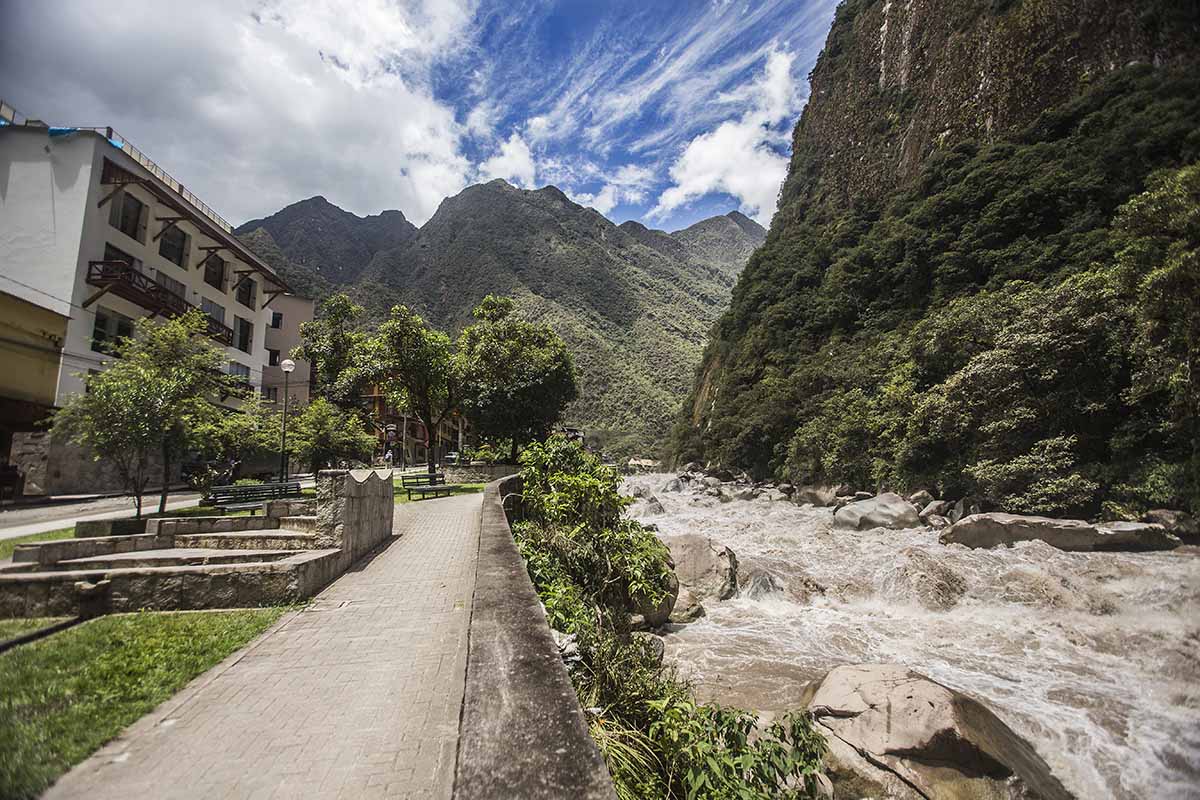
How long will you stay in Aguas Calientes? Photo by Peru For Less.
Multiple itineraries are possible to visit Machu Picchu, ranging from a day trip from Cusco to the classic 4-day Inca Trail. Contact us and our travel experts will organize an epic Machu Picchu and Aguas Calientes experience from start to finish that fits your time and budget.
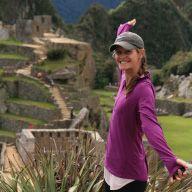
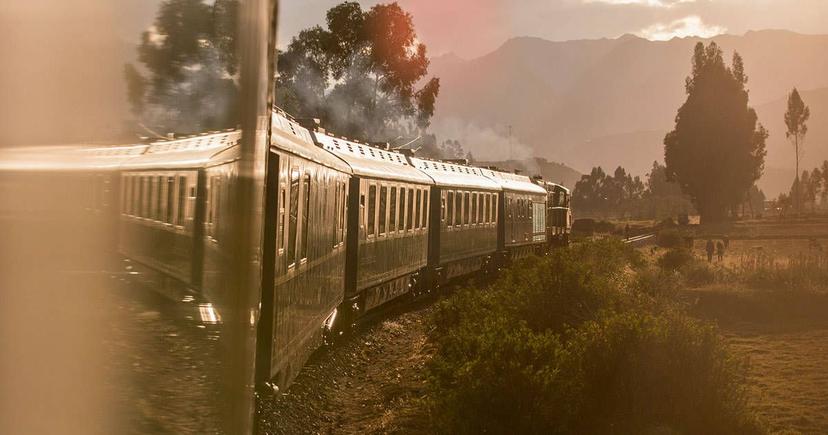
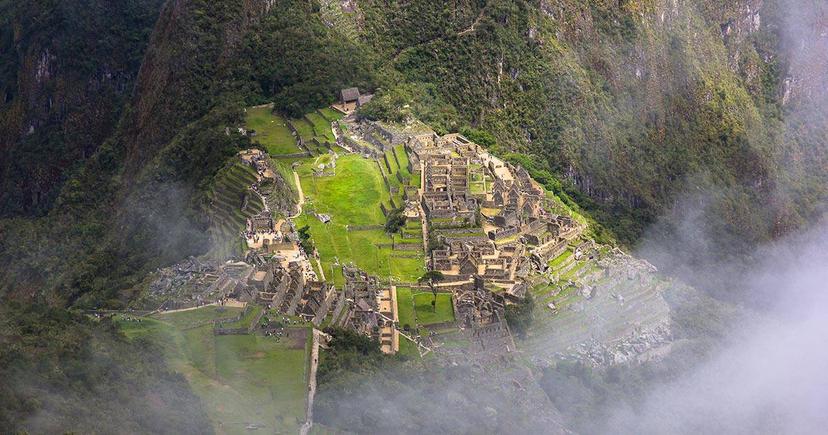
Email: [email protected]
Sign up to receive our newsletter for great articles, stunning photos, and special deals.